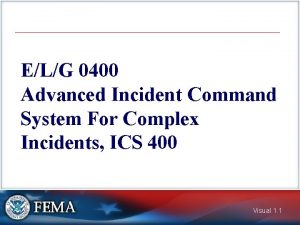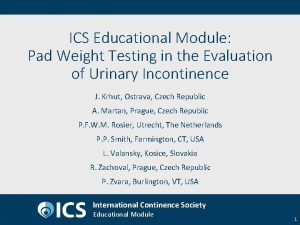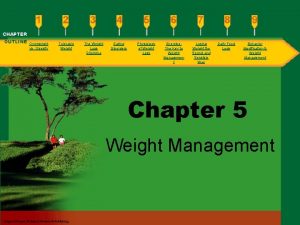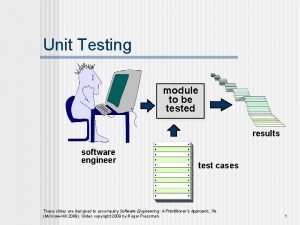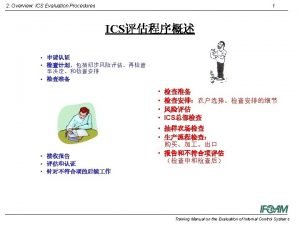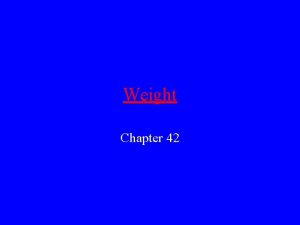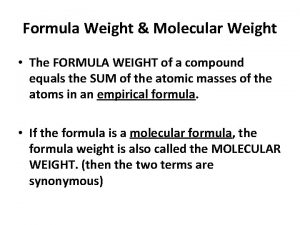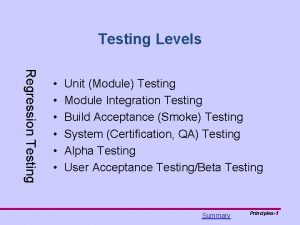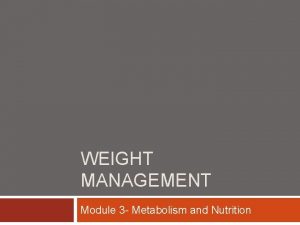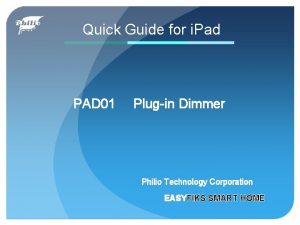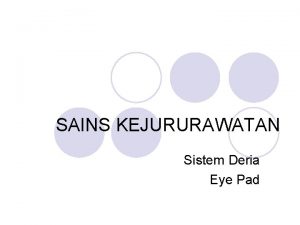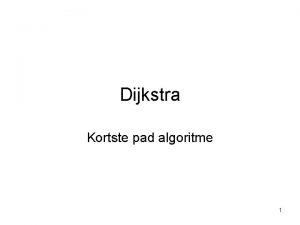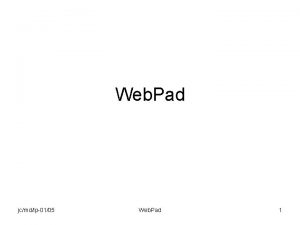ICS Educational Module Pad Weight Testing in the


















- Slides: 18

ICS Educational Module: Pad Weight Testing in the Evaluation of Urinary Incontinence J. Krhut, Ostrava, Czech Republic A. Martan, Prague, Czech Republic P. F. W. M. Rosier, Utrecht, The Netherlands P. P. Smith, Farmington, CT, USA L. Valansky, Kosice, Slovakia R. Zachoval, Prague, Czech Republic P. Zvara, Burlington, VT, USA International Continence Society Educational Module 1

ICS Educational Module • This set of slides should be viewed together with the manuscript, “Pad weight testing in the evaluation of urinary incontinence” Neurourol Urodynam 2014; 33: 507 -10, which provides the scientific background, references, and an evidence-based foundation for the use of pad weight testing in urology. Educational Module 2

Aims of Pad Weight Testing • Qualitative assessment Presence or absence of urinary incontinence • Quantitative assessment Determination of the degree of incontinence Educational Module 3

Principle of Pad Weight Testing • Weight of pads before and after test • Weight gain in grams = urine loss in ml Educational Module 4

Duration of Pad Weight Test Short Term Tests Long Term Tests • 20 min – 2 hrs • 12 hrs – 72 hrs • Qualitative assesssment • Quantitative assessment Educational Module 5

Standardized ICS Pad Weight Test The only pad weight test that has been standardized 1 0 - 15 min: Drinking 500 ml of sodium-free liquid, resting 15 - 45 min: Walking, climbing one flight of stairs (up and down) 45 - 60 min: Standing up from sitting (10 times) Coughing vigorously (10 times) Running in place (1 min) Picking up small object from the floor (5 times) Washing hands in running water (1 min) 1 Seventh report on the standardisation of terminology of lower urinary tract function: lower urinary tract rehabilitation techniques. International Continence Society Committee on Standardisation of Terminology. Scand J Urol Nephrol, 26: 99, 1992 Educational Module 6

Test Preparation Short Term Tests Long Term Tests • Without retrograde filling • With retrograde filling 1 (150 -300 ml or 50 -75% of the bladder capacity) • No retrograde filling Lose, G. , Rosenkilde, P. , Gammelgaard, J. et al. : Pad-weighing test performed with standardized bladder volume. Urology, 32: 78, 1988 Educational Module 7

Perfoming the Pad Weight Test Short Term Tests Long Term Tests • Standardized activities • Normal daily activities • Voiding diary The same technique is usually used for both men and women. Educational Module 8

Cut-Off Values Short Term Tests Long Term Tests • Weight gain > 1. 4 g 1 • Weight gain > 4. 4 g/24 hrs 1 Phenazopyridine could be used if increased perspiration is a factor or if results are inconclusive. 1 Staskin D, Kelleher C, Bosch R, Coyne K, Cotteril N, Emmanuel A, Yoshida M, Kopp Z: Initial assessment of urinary and faecal incontinence in adult male and female patients. In: Incontinence. Ed. : Abrams P, Cardozo L, Khoury S, Wein A. 4 th Ed. Health Publ. Ltd, Paris 2009, pp 333 -412 Educational Module 9

Quantification of Incontinence 1 -hour test 24 -hour test Mild incontinence < 10 ml 4. 4 -20 ml Moderate incontinence 11 -50 ml 21 -74 ml >50 ml >75 ml Severe incontinence O´Sullivan R, Karantanis E, Stevermuer TL, et al. : Definition of mild, moderate and severe incontinence on the 24 -hour pad test. BJOG 2004; 111: 859 -862 Educational Module 10

Is a 1 ml Leak Significant? 1 ml of fluid = 25 drops Educational Module 11

Is a 1 ml Leak Significant? 1 ml of fluid leaked into pad Educational Module 1 ml of fluid leaked into clothing 12

Is a 1 ml Leak Significant? 5 ml of fluid absorbed by pad Educational Module 5 ml of fluid leaked into clothing 13

Sensitivity and Specificity Short Term Tests Long Term Tests • Sensitivity: 34 -83%1, 2 • Sensitivity: no sufficient data • Specificity: no sufficient data • Specificity: 65 -89%2 1 Wu, W. Y. , Sheu, B. C. , Lin, H. H. : Twenty-minute pad test: comparison of infusion of 250 ml of water with strong-desire amount in the bladder in women with stress urinary incontinence. Eur J Obstet Gynecol Reprod Biol, 136: 121, 2008 2 Costantini, E. , Lazzeri, M. , Bini, V. et al. : Sensitivity and specificity of one-hour pad test as a predictive value for female urinary incontinence. Urol Int, 81: 153, 2008 Educational Module 14

Limitations • Lack of standardization • Results of the long term tests may be influenced by: - Fluid intake - Increased voiding frequency - Sweating - Vaginal discharge (up to 7 g/24 hrs)1 - Patient compliance • No value in determining incontinence etiology • Correlation with the degree of the patient's bother is weak 1 Karantanis E, O´Sullivan R, Moore KH: The 24 -hour pad test in continent women and men: normal values and cyclical alterations. BJOG 2003; 110: 567 -571 Educational Module 15

Clinical Conclusions • Pad weight test can provide additional information about degree of incontinence • Easy to perform, inexpensive, risk-free • Could be influenced by many factors • Outcomes should be interpreted in the context of other diagnostic instruments Educational Module 16

Recommendation for Clinical Use • Detailed instruction and patient motivation are crucial • Use short term test for qualitative evaluation of incontinence • If retrograde filling is to be used, bladder should be filled to 50 -75% of its functional capacity Educational Module 17

Recommendation for Clinical Use • Use long term test for quantitative evaluation of incontinence • Interpret test results in conjunction with other relevant assessments (self-assessment questionaires, physical examination, etc. ) • Results of pad weight test don't always correlate with a patient's level of bother Educational Module 18
 Ics 400: advanced ics for complex incidents-aberdeen
Ics 400: advanced ics for complex incidents-aberdeen Pad weight test
Pad weight test Tolerable weight is a body weight
Tolerable weight is a body weight Bulk gaining industries examples
Bulk gaining industries examples C device module module 1
C device module module 1 Module testing in software engineering
Module testing in software engineering Eec test ford
Eec test ford What is domain test
What is domain test Motivational overview of logic based testing
Motivational overview of logic based testing Du path testing
Du path testing Positive testing and negative testing
Positive testing and negative testing Cs 3250
Cs 3250 Localization globalization testing
Localization globalization testing Neighborhood integration testing
Neighborhood integration testing Language testing
Language testing Control structure testing in software engineering
Control structure testing in software engineering Decision table testing in software testing
Decision table testing in software testing Decision table advantages and disadvantages
Decision table advantages and disadvantages Black-box testing disebut juga sebagai behavioral testing
Black-box testing disebut juga sebagai behavioral testing
